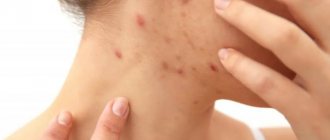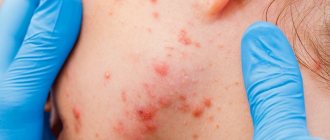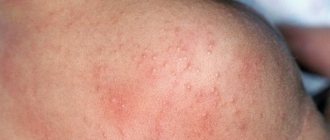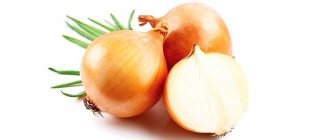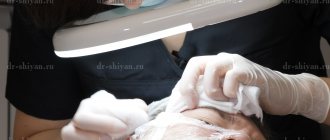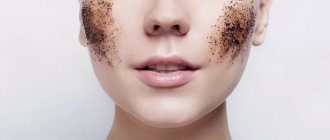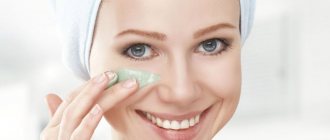Rating: No rating
The appearance of acne on a person’s body always indicates problems brewing in the body. The location and type of rash can say a lot. We invite you to read the material that will help you understand why acne appears on women’s necks and what it means. It is very important to establish the cause of this problem - the methods and ultimately the results of treatment depend on this . You can also learn about the pharmaceutical drugs and folk remedies recommended for use in these cases.
Kinds
Pimples in the neck area vary in appearance. They can be non-infectious or infectious in origin.
Comedones
Their formation occurs in the hair follicle, which is clogged with skin secretions and dead cellular particles of the epidermis.
To treat acne, complex treatment is prescribed: diet therapy; physiotherapy; treatment with systemic antibiotics, hormones, retinoids, antihistamines; For local treatment, antiseptic solutions, ointments with retinoids, and zinc are used.
The main triggers for the appearance of a rash are fried, salty, spicy foods, and foods of animal origin.
There are 2 types of comedones.
Black dots
Inside the plugs that protrude from the surface of the papules, there are epidermal cells and fat. Often the development of a pathological condition is associated with poor hygiene, the use of cosmetics that contain moisturizing components and oils, high air humidity, and excessive contamination of the epidermis.
White dots
They occur against the background of complete blockage of the hair follicle and the excretory duct of the sebaceous gland. Such formations are closed comedones. The contents of the capsule do not penetrate the surface of the epidermis. It accumulates under the top layer, which provokes the formation of a bubble.
Whiteheads are difficult to treat, unlike blackheads.
Papules
This is a consequence of an inflamed comedon. Small red or pink bumps with a soft consistency appear on the skin. The surrounding tissues may be slightly hyperemic. There is pain when touched. Often the pathology is accompanied by itching.
For multiple rashes, consultation with a dermatologist is required.
Pustules
These are ulcers that in most cases arise from comedones. Swelling and redness form around the lesion. Inside, the formation is filled with purulent contents of a yellow or white hue.
Pustular acne can merge with each other, often rising above the epidermis.
Trying to pop a pimple yourself increases the likelihood of scarring or hyperpigmentation.
Nodes
This is a type of subcutaneous formation. The causes are complete blockage of the sebaceous ducts, inflammatory processes of the surrounding soft tissues, irritation.
How to get rid of acne quickly
Acne is a common skin problem, affecting about 85 percent of the population.
The pimple is dense to the touch, grows into the deep layers of the dermis, and is accompanied by painful sensations.
If such acne occurs, medical attention is required.
Cysts
Cystic neoplasms are formed as a result of suppuration of nodular acne against the background of the reproduction and spread of pathogenic microorganisms. Their cavity is filled with pus and looks like boils.
These pimples are painful and soft to the touch. After opening, the formation of atrophic scars is observed in their place.
The pathological condition can recur and requires the help of a dermatologist.
Classification
Pimples on the neck can vary significantly in appearance and can be of infectious or non-infectious origin, these include:
- large red-brown papules or nodules - cavityless elements that change the color of the skin, lie in different layers of the epidermis and usually resolve without leaving a trace;
- vesicles - volumetric formations that have a tire and a bottom, can be filled with serous or purulent-serous contents;
- pustules - pustules, which are presented in the form of phlyctenas, ecthymas, characterized by the development of redness and ulcers around them, and also after resolution - the formation of crusts and scars;
- cysts are accumulated sebum or horny masses in the epidermal formation or directly in the dermis, most often filled with heterogeneous contents.
As they spread, infections can occur on the neck and chest, behind the ears and under the jaw.
Symptoms
Acne is a collective term for rashes. They can be represented by papules, vesicles, spots, pustules, deep-seated nodes.
The clinical picture depends on the nature of the rash and is represented by the following signs:
- redness;
- peeling;
- itching;
- burning;
- soreness;
- swelling.
How to get rid of acne marks
Facial rashes are a common problem that almost every person faces.
The localization of the rash occurs in various areas of the cervical spine. In some patients, the chin is affected, in others - the back of the neck, in others - the entire surface.
Also, acne occurs in single or multiple formations, located locally or spreads to nearby tissues.
There are a lot of pimples on the neck: how to treat it, how to get rid of it if the pimples still itch?
When swelling and redness appear with heavy rashes, this always indicates that active work is underway with bacteria and an immune reaction is activated. Bacteria begin to actively multiply in the clogged pore, the body tries to deliver leukocytes to the damaged areas in the shortest possible time and in large quantities, and reduce the activity of bacteria. It is at this stage that itching and discomfort begins in the form of a slight tingling sensation. So, there are a lot of pimples on the neck - how to treat it, how to get rid of it if the pimples also itch?
As already mentioned, it is imperative to exclude demodicosis, against which the itching is more severe. You also need to know that itching and redness are not necessarily acne, but possibly a sign of an allergic reaction or skin disease such as eczema and dermatitis. For such pathologies, treatment should be started only as prescribed by a doctor.
The correct behavior when itching is to never scratch or injure the already inflamed skin. If such problems regularly arise, it is advisable to:
- Take vitamin complexes with zinc and copper.
- Take vitamins A and E in capsules, especially with selenium. They accelerate the regeneration of injured skin.
- After consulting a specialist, carry out local antibacterial therapy. These are usually alcohol-based solutions that facilitate deep penetration of the active ingredients. Antibiotics may also be prescribed in the form of an ointment.
It is also possible to prescribe hormonal drugs, but only by a specialist. Self-medication is dangerous for skin health.
Causes
Acne occurs due to blockage of the skin ducts, which occurs when the sebaceous glands are overactive. The accumulation of fat on the surface of the dermis creates favorable conditions for the development of pathogenic microflora, which causes inflammation of local tissues.
Why can our articles be trusted?
We make health information clear, accessible and relevant.
- All articles are checked by practicing doctors.
- We take scientific literature and the latest research as a basis.
- We publish detailed articles that answer all questions.
The second most common cause of acne on the neck is considered to be poor personal hygiene.
The accumulation of dirt on the skin also interferes with the normal functioning of the glands and creates a breeding ground for pathogenic microorganisms.
Possible causes of acne include:
- an allergic reaction accompanied by intense itching;
- synthetic clothing, which interferes with the work of the sweat glands and causes skin irritation;
- frequent use of cosmetics.
How to relieve acne inflammation
Acne is a widespread problem.
During the period of hormonal changes in the body (during menopause, pregnancy), the concentration of androgens in the body increases. The active synthesis of these hormones also causes intensive work of the sebaceous glands.
In addition to these reasons, hormonal imbalance is provoked by oral contraceptives and pathologies of the endocrine system.
If women have acne on their body and do not go away for a long time, then they need to undergo an examination of the genitourinary system. Polycystic ovary syndrome provokes the appearance of acne. Also, the course of the pathology is accompanied by active growth of body hair and increased sweating.
Acne appears on the back of the neck more often in the summer. Local tissues become inflamed due to the active work of the sweat glands.
A painful pimple can be caused by poor diet:
- alcohol;
- binge eating;
- fatty foods.
If numerous rashes have formed on the neck, it is necessary to make adjustments to the daily diet, giving up:
- fatty, fried and smoked foods;
- semi-finished products;
- mayonnaise;
- chocolate;
- milk;
- spices
Phototherapy for acne
Acne is an inflammatory skin disease caused by a disorder in the hair follicles and sebaceous glands.
The appearance of acne on the body is caused by pathologies of the gastrointestinal tract:
- peptic ulcer;
- gastritis;
- dysbiosis.
Massive accumulation of acne on the neck is observed in women who have been taking antibacterial drugs for a long time. Antibiotics, penetrating the stomach and intestines, suppress the local microflora.
A decrease in the concentration of microorganisms responsible for digesting food leads to an increase in the concentration of toxins.
If the diagnosis does not reveal any of the above causative factors, then the appearance of acne on the neck can be explained by the activity of demodex. This mite is constantly present on human skin.
During the period when the immune system is weakened, demodex is activated. Mite waste products cause an allergic reaction in some people, manifested in the form of pimples on the neck and itching.
General information
Pimples on the neck are not only discomfort and a cosmetic defect, but also a signal from the body about the development of a pathological process. You can directly consider acne - pimples of various origins and other types of manifestations of diseases, for example, impetigo, diathesis, superficial dermatitis, skin tuberculosis, syphilis, neurosis , etc.
A skin rash behind the ears and on the neck is essentially a typical reaction of the body to external and internal changes and disruptions in the body. The reasons can be very diverse, ranging from bacteria, viruses, allergic reactions , but most often they are dermatological diseases.
Diagnostics
Sometimes determining the root cause of acne does not cause any difficulties. For example, if there is a disappearance of rashes after taking a bath, then the pathological condition could be caused by neglect of basic hygiene rules.
Certain difficulties arise when internal causes act as a provoking factor. In such a situation, careful diagnosis is required.
If acne appears that does not go away for a long time, causing some discomfort and unpleasant sensations, you should seek help from a dermatologist. First, the doctor performs an external examination, collects the necessary information regarding the patient’s life history and prescribes an appropriate examination.
Acne facial cleansing
Facial cleansing is a special procedure, the purpose of which is to cleanse the skin of various purulent formations.
The person is given a referral for a blood and urine test. Also do:
- allergy tests;
- biochemistry;
- Demodex mite detection test;
- dermatoscopy;
- biopsy followed by histology.
If this is not enough, an ultrasound examination of the cervical spine is performed. Thanks to this diagnostic method, it is possible to establish pathological processes in this area, which may be accompanied by characteristic rashes on the surface or in the deep layers of the epidermis.
If necessary, additional consultation with a gastroenterologist, infectious disease specialist, endocrinologist and others may also be required.
Subcutaneous, large, painful pimples under the neck, on the back: causes
Subcutaneous pimples differ from regular rashes not only in appearance and pain, but also in the fact that getting rid of them is not so easy. A subcutaneous pimple forms in the deep layers under the dermis and is characterized by prolonged maturation, pain, and swelling. Many people try to get rid of them on their own; attempts to squeeze them out on their own are especially dangerous: such manipulations always leave scars at the site of the pimple, or even fistulas form. Why do subcutaneous, large, painful pimples appear under the neck and on the back?
The reasons for the formation of subcutaneous formations are varied and similar to other types of acne, but there is one distinctive feature - subcutaneous mite (Demodex) . Therefore, it is so important to consult a specialist in time to exclude demodicosis.
In addition to this pathology, possible causes are:
- Pregnancy
- Menopause
- Adrenal and other endocrine disorders
- Eating disorder
- Dermatovenerological diseases
- Frequent and aggressive peeling
At the first stage, the formation of a pimple is invisible, slight discomfort and redness are possible.
At the second stage, a noticeable compaction appears, the size of which grows over several days and becomes visually noticeable.
At the third stage, the pimple is ripe. This is already an impressive, painful tubercle with a white or black top.
Treatment methods
It is recommended to select treatment based on the causative factor. To remove acne from the body, you should regularly treat problem areas of the skin with salicylic acid. This substance:
Self-medication is dangerous with complications!
Attention
Despite the fact that our articles are based on trusted sources and have been tested by practicing doctors, the same symptoms can be signs of different diseases, and the disease may not proceed according to the textbook.
Pros of seeing a doctor:
- Only a specialist will prescribe suitable medications.
- Recovery will be easier and faster.
- The doctor will monitor the course of the disease and help avoid complications.
find a doctor
Do not try to treat yourself - consult a specialist.
- destroys pathogenic microorganisms;
- suppresses the inflammatory process;
- removes keratinized tissue.
Salicylic acid is found in many anti-acne products.
To suppress the activity of pathogenic microorganisms that cause inflammation of the skin, the surface of the dermis should be treated with antibacterial drugs.
If acne occurs against the background of systemic pathologies, then drugs in the form of tablets are used:
- For hormonal disorders, oral contraceptives .
- In case of helminthic infestation or infection of the dermis, tetracycline antibiotics
- For dysfunction of the gastrointestinal tract, sorbents and medications with colonies of beneficial bacteria are used. The latter normalize the functioning of the gastrointestinal tract, stimulate metabolism and accelerate the removal of toxins from the body.
When small pimples appear due to an allergic reaction, it is necessary to eliminate the causative factor (allergen).
It is highly not recommended to squeeze out blackheads. After the pimple opens, the problem area should be treated with antiseptic solutions or alcohol. This will avoid the addition of a secondary infection and suppuration of the skin.
Pimples on the neck in women appear due to the active work of the sebaceous glands or diseases of the endocrine system. These factors create favorable conditions for the development of a colony of pathogenic microorganisms, which cause inflammation of the dermal tissue. In the treatment of acne, a complex of drugs is used that affect both acne and the cause of its occurrence.
How to choose the right product
Depending on the type of acne, you need to select products that successfully fight them - medications or from the arsenal of traditional medicine.
Pharmacy drugs
- Antibiotic drugs are used for purulent acne. They usually contain an antibiotic of the tetracycline group. They actively destroy foci of inflammation and suppuration. The doctor may prescribe oral tetracycline, erythromycin, and clindamycin.
- Retinoids - ointments such as Adapalene, Klenzit, Effezel - do an excellent job with any acne,
- The use of salicylic alcohol helps to dry and disinfect both purulent rashes and allergies and colds.
- - Anti-acne tablets of different compositions, prepared in pharmacies, contain different combinations of drugs - boric and salicylic acid, streptocide, chloramphenicol, alcohol, and so on. Works well on acne of any origin.
- Hormonal drugs, such as Triderm ointment or cream, Prednisolone, Betaderm, are used in complex cases with global skin lesions within a strictly prescribed time frame.
According to user reviews, the most popular drugs are calendula tincture, Tsindol mash, salicylic acid solution, Skinoren, Baziron, Levomekol, Baneocin, Vishnevsky ointment.
Folk remedies
Folk remedies that can be used together with medications can be an excellent support in the fight against acne on the neck. We recommend several popular and proven recipes.
- —Tar soap—excellently disinfects the skin, normalizes the acid-base balance, and promotes regeneration.
- Herbal compress prepared according to the recipe: mix chamomile, hops and St. John's wort in equal proportions. Brew 1 tablespoon of herbal tea in a glass of boiling water. As soon as it cools down, strain and add a spoonful of apple cider vinegar. Apply a compress to problem areas for 20 minutes.
- An excellent anti-acne lotion is prepared from aloe leaves, which should be used four times a day. For it you will need plant leaves that have been in the refrigerator for a week. The leaves need to be crushed in a blender. Place a glass of this puree in a liter of water, let stand for a couple of hours, and then bring to a boil. After cooling, you need to filter it and you can use it.
- A cinnamon scrub combines several functions at once - cleansing, exfoliating and nourishing. To do this, you need to combine a tablespoon of honey and a teaspoon of ground cinnamon. Apply to the neck with light massaging movements. After 20 minutes you can wash it off.
- If there are no open wounds, you can use garlic lotion. To prepare, you need to grind a couple of cloves and place them in a liter of water for a day. You can add the juice of half a lemon. Clean problem areas 2-3 times a day with a cotton pad.
Consequences
With mechanical impact, an attempt to squeeze out the growth on your own, or the absence of therapeutic measures, the following occur:
- inflammatory processes;
- tissue scarring;
- subcutaneous seals that are difficult to treat with medication.
If you try to squeeze out the growth yourself, its contents can come out not only outside, but also deep into the tissue structures. When it enters the bloodstream or lymph flow, the pathological fluid spreads throughout the body, which can cause sepsis.
What to do when acne hurts, itches and does not go away
- Try to wear regular T-shirts or shirts without collars. If you need to wear shirts with a collar (sometimes this is necessary), it is advisable to purchase products made from soft cotton fabrics that are not harmful to the skin.
- Avoid touching sensitive areas on your neck during the day.
- During the onset of acne, try to keep your hair short and avoid anything that may irritate your neck.
- Be careful when sweating, do not touch areas with inflamed comedones with unwashed hands or a stale handkerchief.
Our body is constantly in contact with various things, and it is impossible to completely prevent irritation. But knowing about the little things described above, you can protect yourself from the occurrence of new acne and inflammation of old ones.
Very often, the appearance of acne or skin rashes is accompanied by itching and pain. Under no circumstances should you squeeze pimples or scratch them. Thus, you spread bacteria and add new problems to yourself.
Why do pimples itch? This is how the body notifies us about a problem, makes us think about it and look for ways to solve it. A very common cause of itchy pimples is an allergic reaction to some new product or cosmetic.
Perhaps some new plant or animal has appeared in your home, or maybe you just bought a new thing. Try to remember what you have recently eaten that is not quite familiar to your body; perhaps you have purchased some new cream or perfume.
This plant is especially popular in medicine. Aloe juice helps restore affected areas, relieves inflammation, has a “pulling” effect, and removes redness. If you put aloe leaves in the refrigerator for 2-3 days before use, it will be more effective.
Prevention
To prevent the skin from undergoing changes, you need to adhere to preventive measures.
Choice of clothes
Clothes should be chosen only from natural fabrics. It is better to avoid shirts, sweaters, and dresses with long collars. They cause constant friction with the skin and increase sweating, which can cause acne.
Hair
If they are long, they must be periodically tied into a ponytail or bun. Such actions will ensure an influx of oxygen, the epidermis will breathe.
Disguise
Do not use cosmetics to disguise rashes. This leads to even greater clogging of the pores, resulting in the active proliferation of pathogenic bacteria.
Hygiene
The body, including the neck, must be kept clean at all times. To do this, it is necessary not only to take a shower every day, but also to wash bedding and clothes, even without visible signs of contamination, at least once a week.
Diet
Proper nutrition plays an important role in preventing acne. Harmful and low-quality foods are completely excluded from the diet. To maintain normal functioning of the body, experts recommend eating foods rich in zinc, vitamins A, E and B. The menu includes asparagus, beef, calf liver, spinach, nuts, black currants, and rose hips.
If you are predisposed to developing rashes on the neck, it is necessary to limit the consumption of large quantities of fruits and vegetables, salty, spicy and fried foods, strong coffee, sweets and smoked foods.
The daily intake of clean water should not be less than 1.5 liters.
Pathogenesis
Pimples on the neck can appear in several ways:
- infectious-inflammatory - the most common cause of acne is dirty clothes and hands, which are a source of bacterial infection (propionibacterium acne, mycobacterium tuberculosis, various cocci) and, as a result, lead to rashes;
- allergic - any products, fabrics and medications with individual intolerance or hypersensitivity can cause a skin reaction on any part of the body;
- endocrinological - failures and restructuring of the ovaries and male genital appendages, disruption of the neuroendocrine regulation of the endocrine glands - all this is reflected on the skin and leads to overproduction of sebum, as a result, the pores become clogged with dying corneocytes and block the work of skin follicles.
What affects the course of acne?
Acne should be treated under the supervision of a doctor and all possible factors that influence the course of the disease should be taken into account:
- Exposure to stress. As such, it does not cause acne, but it significantly aggravates its course.
- Food. According to many dermatologists, food is not the cause of acne (except for drinking whole milk), but a diet that excludes carbohydrates and fats significantly speeds up healing.
- Increased humidity and sweating have a negative impact on the course of the disease.
- Artificial ultraviolet light enhances the formation of comedones and increases sebum production. Many women note that acne appears after tanning.
- Nicotine has a negative effect and slows down recovery.
